remote control BMW M5 2003 E39 Central Body Electronics ZKE Manual
[x] Cancel search | Manufacturer: BMW, Model Year: 2003, Model line: M5, Model: BMW M5 2003 E39Pages: 80, PDF Size: 4.14 MB
Page 21 of 80
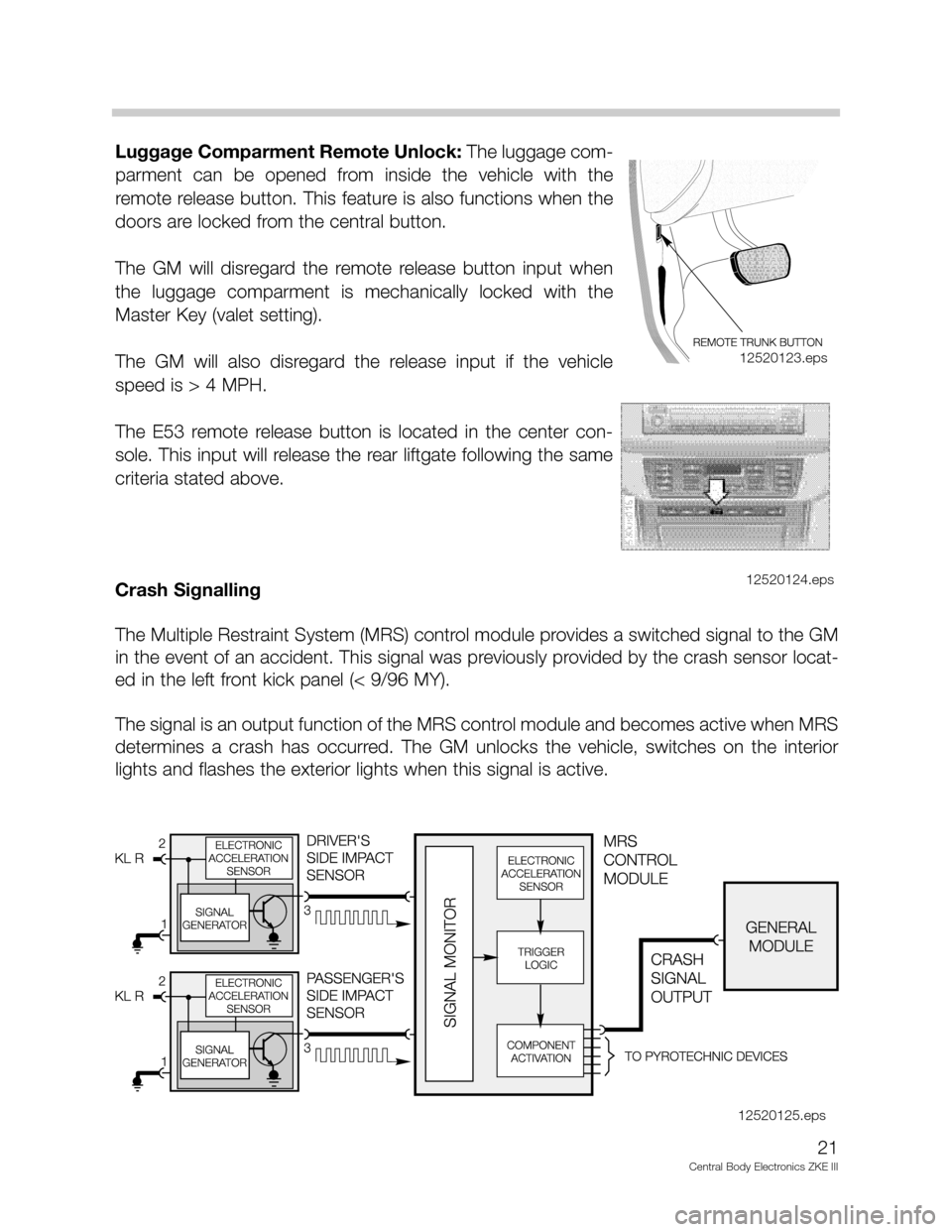
Luggage Comparment Remote Unlock: The luggage com-
parment can be opened from inside the vehicle with the
remote release button. This feature is also functions when the
doors are locked from the central button.
The GM will disregard the remote release button input when
the luggage comparment is mechanically locked with the
Master Key (valet setting).
The GM will also disregard the release input if the vehicle
speed is > 4 MPH.
The E53 remote release button is located in the center con-
sole. This input will release the rear liftgate following the same
criteria stated above.
Crash Signalling
The Multiple Restraint System (MRS) control module provides a switched signal to the GM
in the event of an accident. This signal was previously provided by the crash sensor locat-
ed in the left front kick panel (< 9/96 MY).
The signal is an output function of the MRS control module and becomes active when MRS
determines a crash has occurred. The GM unlocks the vehicle, switches on the interior
lights and flashes the exterior lights when this signal is active.
21
Central Body Electronics ZKE III
12520123.eps
12520124.eps
12520125.eps
Page 25 of 80
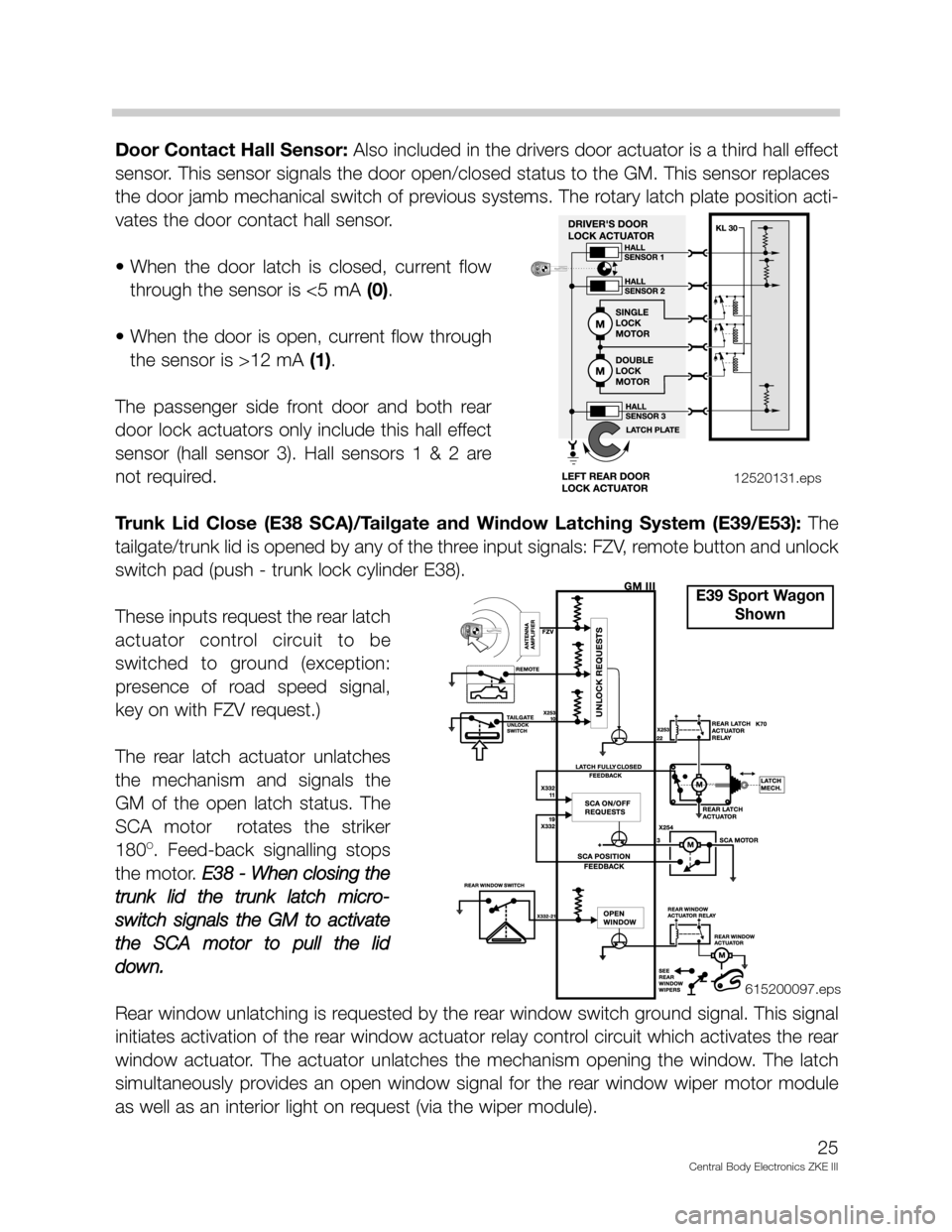
Door Contact Hall Sensor: Also included in the drivers door actuator is a third hall effect
sensor. This sensor signals the door open/closed status to the GM. This sensor replaces
the door jamb mechanical switch of previous systems. The rotary latch plate position acti-
vates the door contact hall sensor.
• When the door latch is closed, current flow
through the sensor is <5 mA (0).
• When the door is open, current flow through
the sensor is >12 mA (1).
The passenger side front door and both rear
door lock actuators only include this hall effect
sensor (hall sensor 3). Hall sensors 1 & 2 are
not required.
Trunk Lid Close (E38 SCA)/Tailgate and Window Latching System (E39/E53): The
tailgate/trunk lid is opened by any of the three input signals: FZV, remote button and unlock
switch pad (push - trunk lock cylinder E38).
These inputs request the rear latch
actuator control circuit to be
switched to ground (exception:
presence of road speed signal,
key on with FZV request.)
The rear latch actuator unlatches
the mechanism and signals the
GM of the open latch status. The
SCA motor rotates the striker
180
O. Feed-back signalling stops
the motor. E38 - When closing the
trunk lid the trunk latch micro-
switch signals the GM to activate
the SCA motor to pull the lid
down.
Rear window unlatching is requested by the rear window switch ground signal. This signal
initiates activation of the rear window actuator relay control circuit which activates the rear
window actuator. The actuator unlatches the mechanism opening the window. The latch
simultaneously provides an open window signal for the rear window wiper motor module
as well as an interior light on request (via the wiper module).
25
Central Body Electronics ZKE III
12520131.eps
E39 Sport Wagon
Shown
615200097.eps
Page 26 of 80
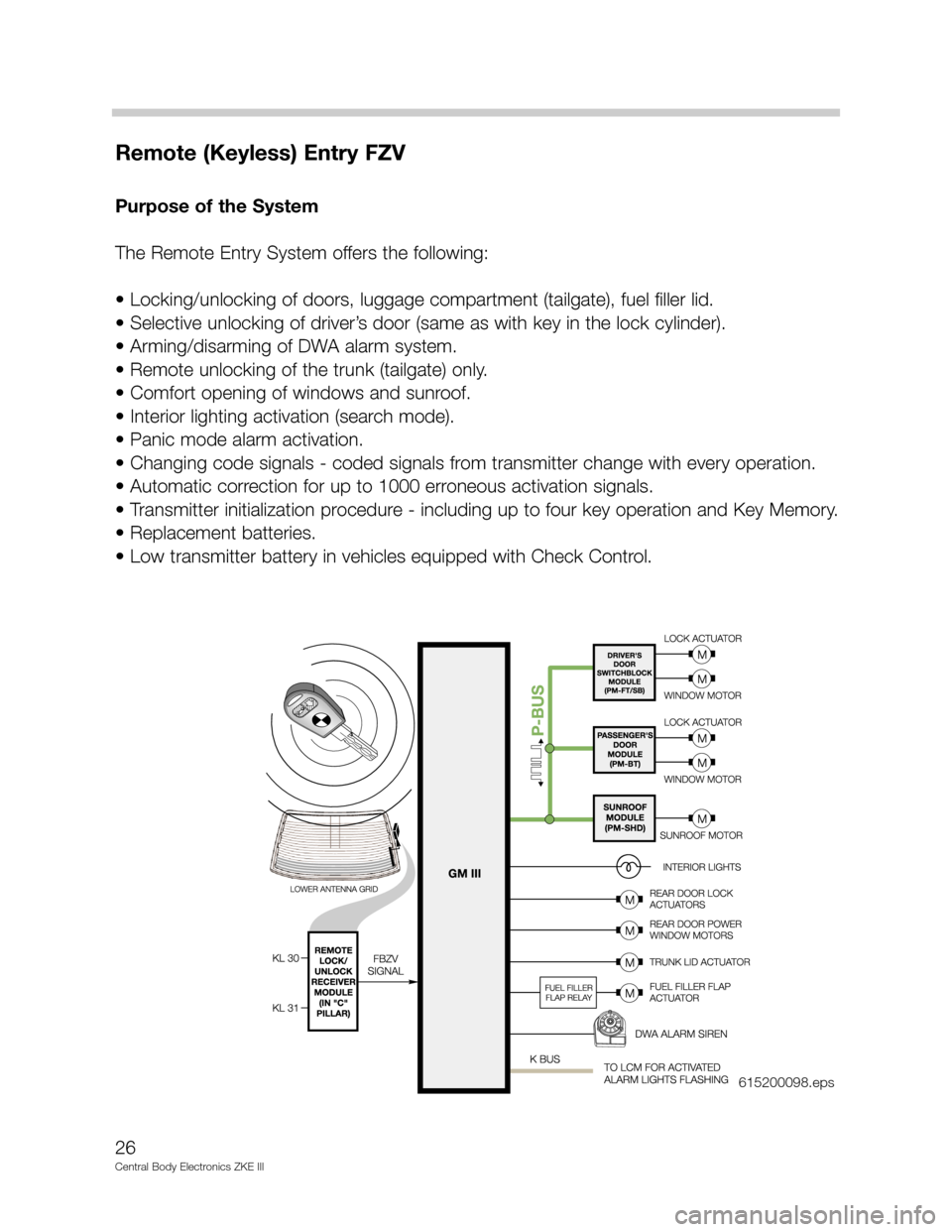
Remote (Keyless) Entry FZV
Purpose of the System
The Remote Entry System offers the following:
• Locking/unlocking of doors, luggage compartment (tailgate), fuel filler lid.
• Selective unlocking of driver’s door (same as with key in the lock cylinder).
• Arming/disarming of DWA alarm system.
• Remote unlocking of the trunk (tailgate) only.
• Comfort opening of windows and sunroof.
• Interior lighting activation (search mode).
• Panic mode alarm activation.
• Changing code signals - coded signals from transmitter change with every operation.
• Automatic correction for up to 1000 erroneous activation signals.
• Transmitter initialization procedure - including up to four key operation and Key Memory.
• Replacement batteries.
• Low transmitter battery in vehicles equipped with Check Control.
26
Central Body Electronics ZKE III
615200098.eps
Page 27 of 80
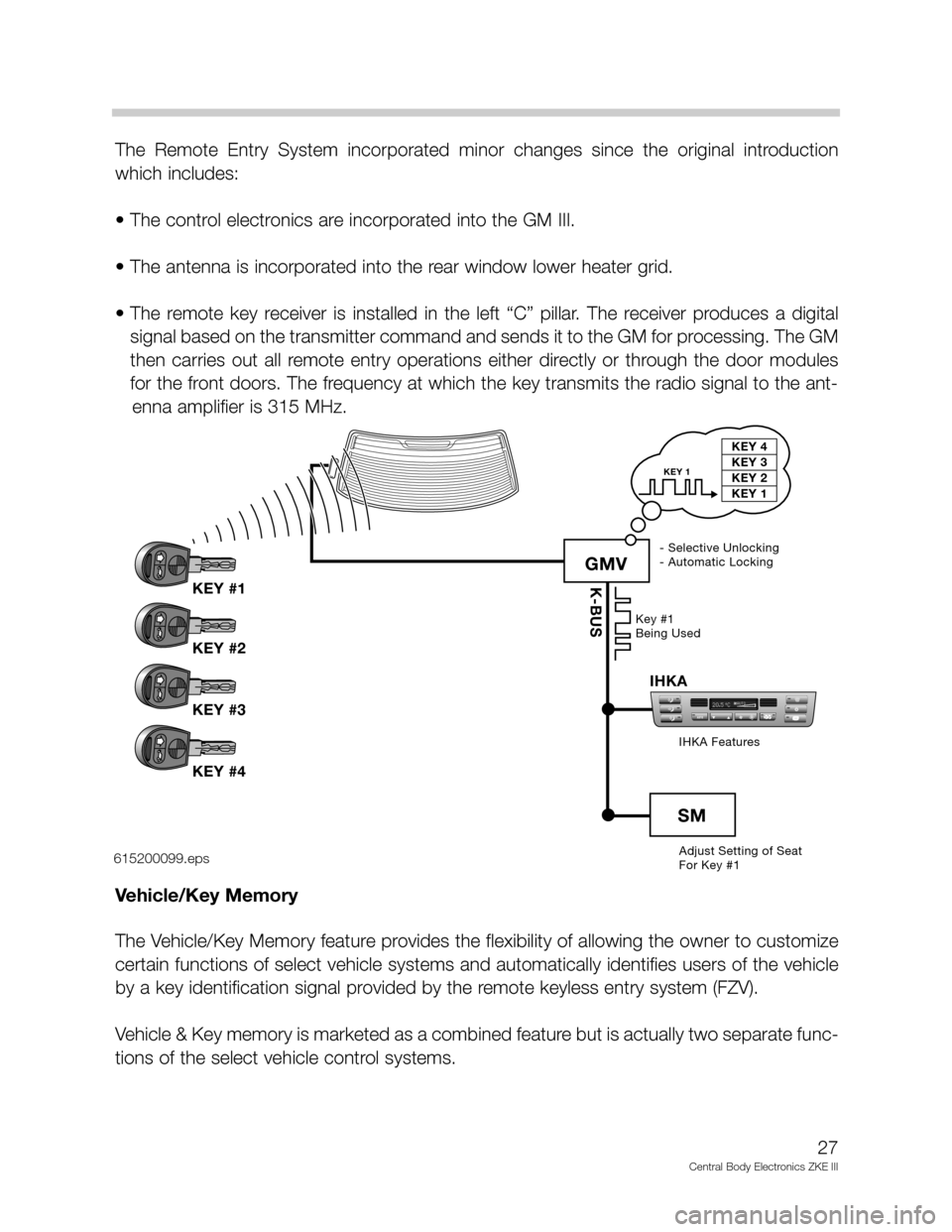
The Remote Entry System incorporated minor changes since the original introduction
which includes:
• The control electronics are incorporated into the GM III.
• The antenna is incorporated into the rear window lower heater grid.
• The remote key receiver is installed in the left “C” pillar. The receiver produces a digital
signal based on the transmitter command and sends it to the GM for processing. The GM
then carries out all remote entry operations either directly or through the door modules
for the front doors. The frequency at which the key transmits the radio signal to the ant-
enna amplifier is 315 MHz.
Vehicle/Key Memory
The Vehicle/Key Memory feature provides the flexibility of allowing the owner to customize
certain functions of select vehicle systems and automatically identifies users of the vehicle
by a key identification signal provided by the remote keyless entry system (FZV).
Vehicle & Key memory is marketed as a combined feature but is actually two separate func-
tions of the select vehicle control systems.
27
Central Body Electronics ZKE III
A
IHKA
K-BUSKEY #1
KEY #2
KEY #3
KEY #4
GMV
SM
Adjust Setting of Seat
For Key #1 IHKA Features Key #1
Being Used
KEY 4
KEY 3
KEY 2
KEY 1
KEY 1
- Selective Unlocking
- Automatic Locking
615200099.eps
Page 31 of 80
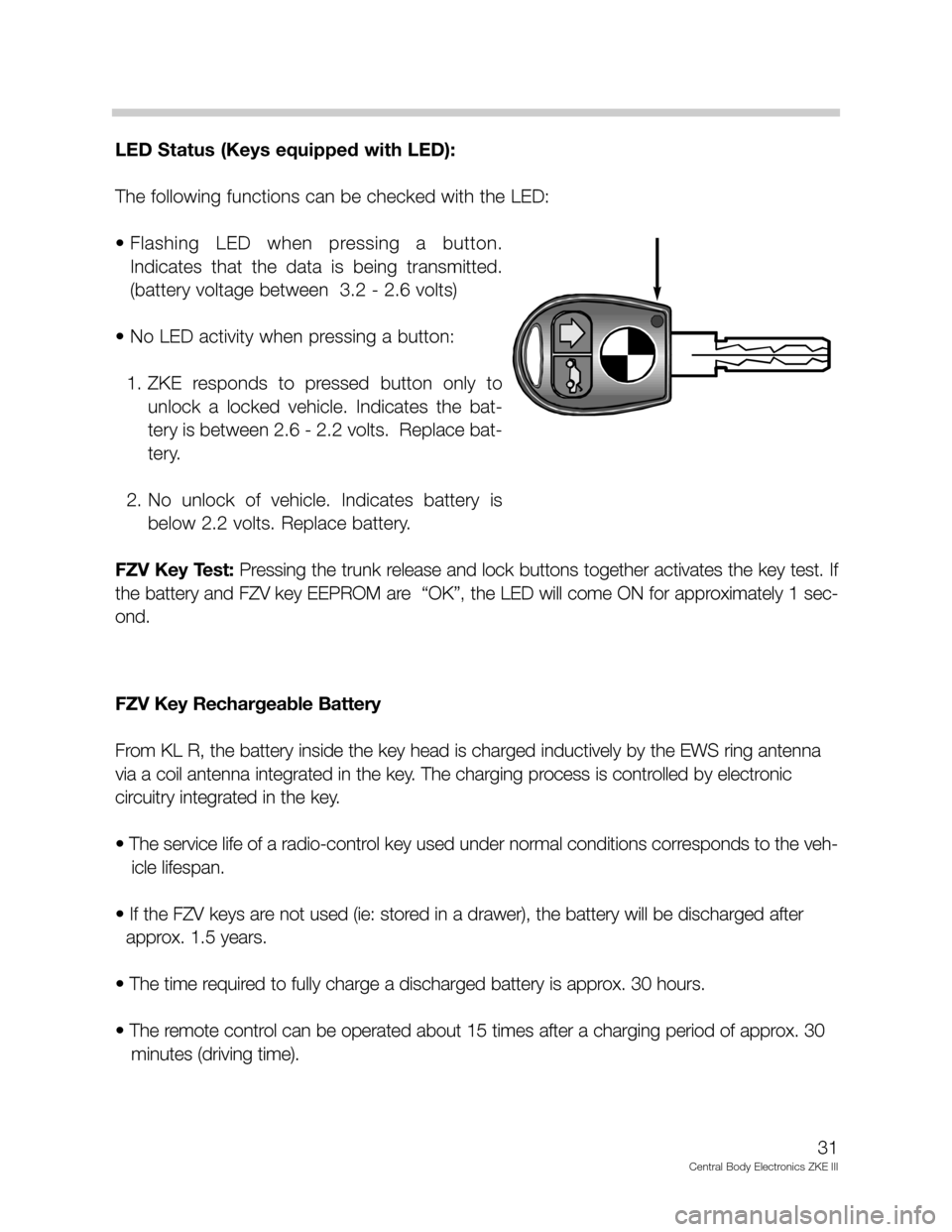
LED Status (Keys equipped with LED):
The following functions can be checked with the LED:
• Flashing LED when pressing a button.
Indicates that the data is being transmitted.
(battery voltage between 3.2 - 2.6 volts)
• No LED activity when pressing a button:
1. ZKE responds to pressed button only to
unlock a locked vehicle. Indicates the bat-
tery is between 2.6 - 2.2 volts. Replace bat-
tery.
2. No unlock of vehicle. Indicates battery is
below 2.2 volts. Replace battery.
FZV Key Test: Pressing the trunk release and lock buttons together activates the key test. If
the battery and FZV key EEPROM are “OK”, the LED will come ON for approximately 1 sec-
ond.
FZV Key Rechargeable Battery
From KL R, the battery inside the key head is charged inductively by the EWS ring antenna
via a coil antenna integrated in the key. The charging process is controlled by electronic
circuitry integrated in the key.
• The service life of a radio-control key used under normal conditions corresponds to the veh-
icle lifespan.
• If the FZV keys are not used (ie: stored in a drawer), the battery will be discharged after
approx. 1.5 years.
• The time required to fully charge a discharged battery is approx. 30 hours.
• The remote control can be operated about 15 times after a charging period of approx. 30
minutes (driving time).
31
Central Body Electronics ZKE III
Page 33 of 80
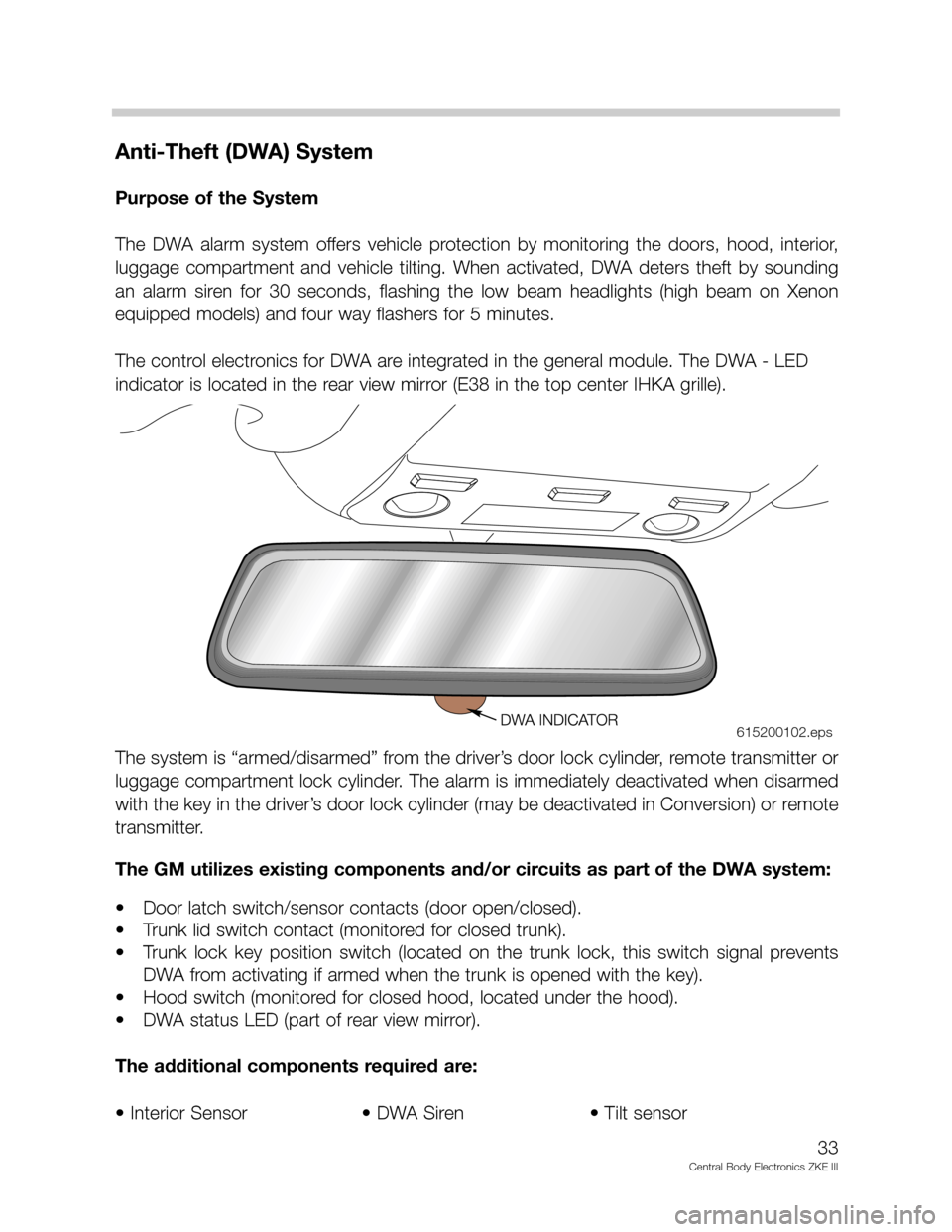
Anti-Theft (DWA) System
Purpose of the System
The DWA alarm system offers vehicle protection by monitoring the doors, hood, interior,
luggage compartment and vehicle tilting. When activated, DWA deters theft by sounding
an alarm siren for 30 seconds, flashing the low beam headlights (high beam on Xenon
equipped models) and four way flashers for 5 minutes.
The control electronics for DWA are integrated in the general module. The DWA - LED
indicator is located in the rear view mirror (E38 in the top center IHKA grille).
The system is “armed/disarmed” from the driver’s door lock cylinder, remote transmitter or
luggage compartment lock cylinder. The alarm is immediately deactivated when disarmed
with the key in the driver’s door lock cylinder (may be deactivated in Conversion) or remote
transmitter.
The GM utilizes existing components and/or circuits as part of the DWA system:
• Door latch switch/sensor contacts (door open/closed).
• Trunk lid switch contact (monitored for closed trunk).
• Trunk lock key position switch (located on the trunk lock, this switch signal prevents
DWA from activating if armed when the trunk is opened with the key).
• Hood switch (monitored for closed hood, located under the hood).
• DWA status LED (part of rear view mirror).
The additional components required are:
• Interior Sensor • DWA Siren • Tilt sensor
33
Central Body Electronics ZKE III
615200102.eps
Page 43 of 80
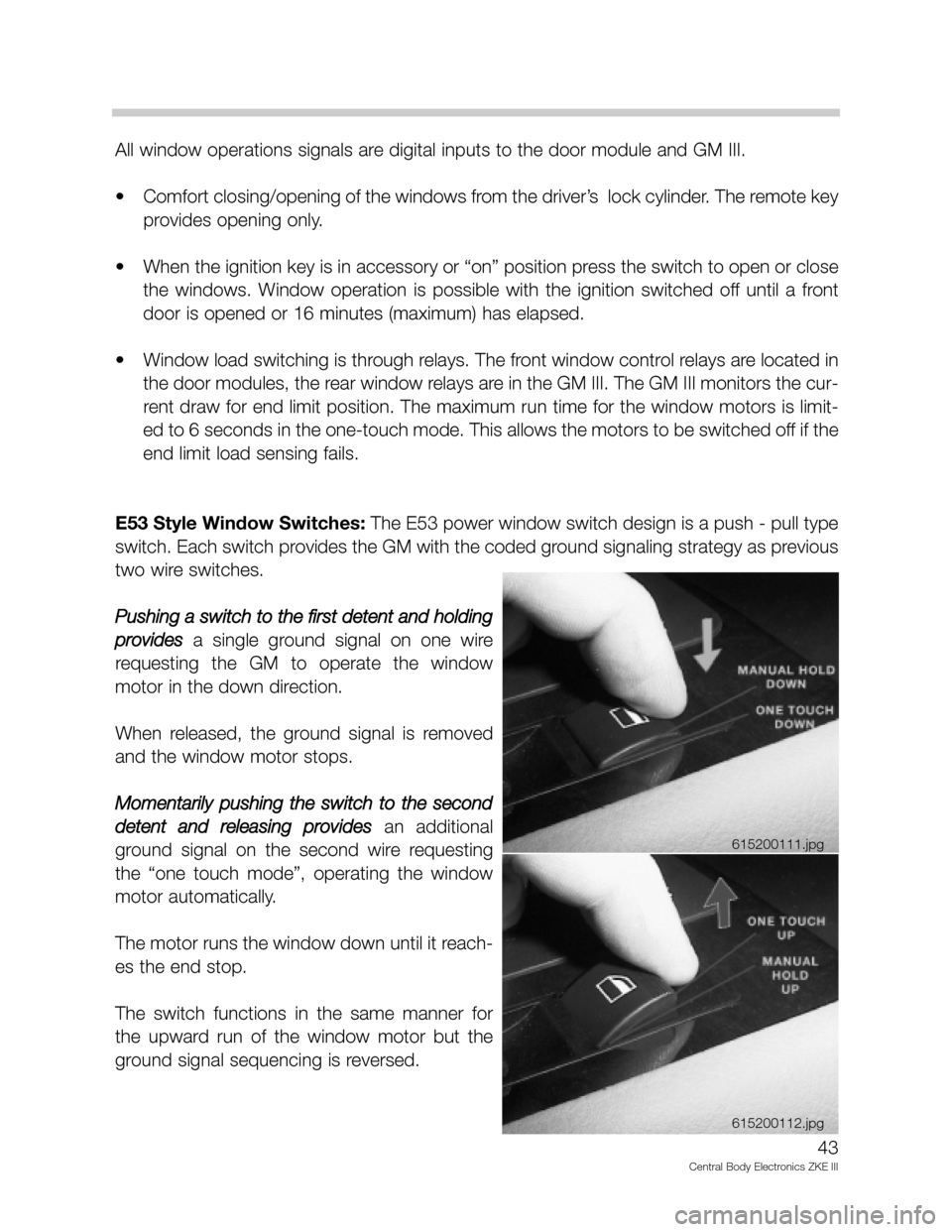
All window operations signals are digital inputs to the door module and GM III.
• Comfort closing/opening of the windows from the driver’s lock cylinder. The remote key
provides opening only.
• When the ignition key is in accessory or “on” position press the switch to open or close
the windows. Window operation is possible with the ignition switched off until a front
door is opened or 16 minutes (maximum) has elapsed.
• Window load switching is through relays. The front window control relays are located in
the door modules, the rear window relays are in the GM III. The GM III monitors the cur-
rent draw for end limit position. The maximum run time for the window motors is limit-
ed to 6 seconds in the one-touch mode. This allows the motors to be switched off if the
end limit load sensing fails.
E53 Style Window Switches:The E53 power window switch design is a push - pull type
switch. Each switch provides the GM with the coded ground signaling strategy as previous
two wire switches.
Pushing a switch to the first detent and holding
provides
a single ground signal on one wire
requesting the GM to operate the window
motor in the down direction.
When released, the ground signal is removed
and the window motor stops.
Momentarily pushing the switch to the second
detent and releasing provides
an additional
ground signal on the second wire requesting
the “one touch mode”, operating the window
motor automatically.
The motor runs the window down until it reach-
es the end stop.
The switch functions in the same manner for
the upward run of the window motor but the
ground signal sequencing is reversed.
43
Central Body Electronics ZKE III
615200111.jpg
615200112.jpg
Page 51 of 80
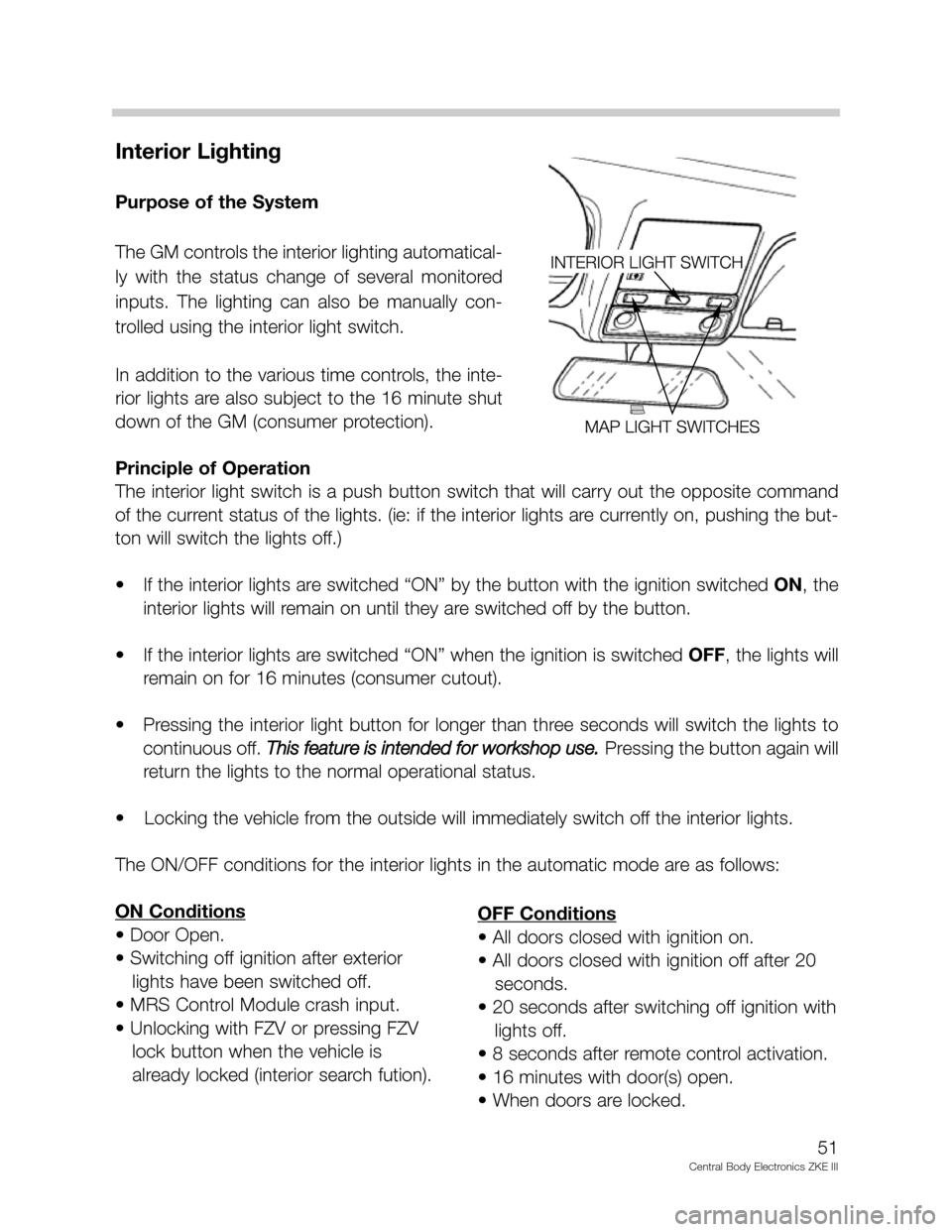
Interior Lighting
Purpose of the System
The GM controls the interior lighting automatical-
ly with the status change of several monitored
inputs. The lighting can also be manually con-
trolled using the interior light switch.
In addition to the various time controls, the inte-
rior lights are also subject to the 16 minute shut
down of the GM (consumer protection).
Principle of Operation
The interior light switch is a push button switch that will carry out the opposite command
of the current status of the lights. (ie: if the interior lights are currently on, pushing the but-
ton will switch the lights off.)
• If the interior lights are switched “ON” by the button with the ignition switched ON, the
interior lights will remain on until they are switched off by the button.
• If the interior lights are switched “ON” when the ignition is switched OFF, the lights will
remain on for 16 minutes (consumer cutout).
• Pressing the interior light button for longer than three seconds will switch the lights to
continuous off. This feature is intended for workshop use.
Pressing the button again will
return the lights to the normal operational status.
• Locking the vehicle from the outside will immediately switch off the interior lights.
The ON/OFF conditions for the interior lights in the automatic mode are as follows:
ON Conditions
• Door Open.
• Switching off ignition after exterior
lights have been switched off.
• MRS Control Module crash input.
• Unlocking with FZV or pressing FZV
lock button when the vehicle is
already locked (interior search fution).
51
Central Body Electronics ZKE III
OFF Conditions
• All doors closed with ignition on.
• All doors closed with ignition off after 20
seconds.
• 20 seconds after switching off ignition with
lights off.
• 8 seconds after remote control activation.
• 16 minutes with door(s) open.
• When doors are locked.